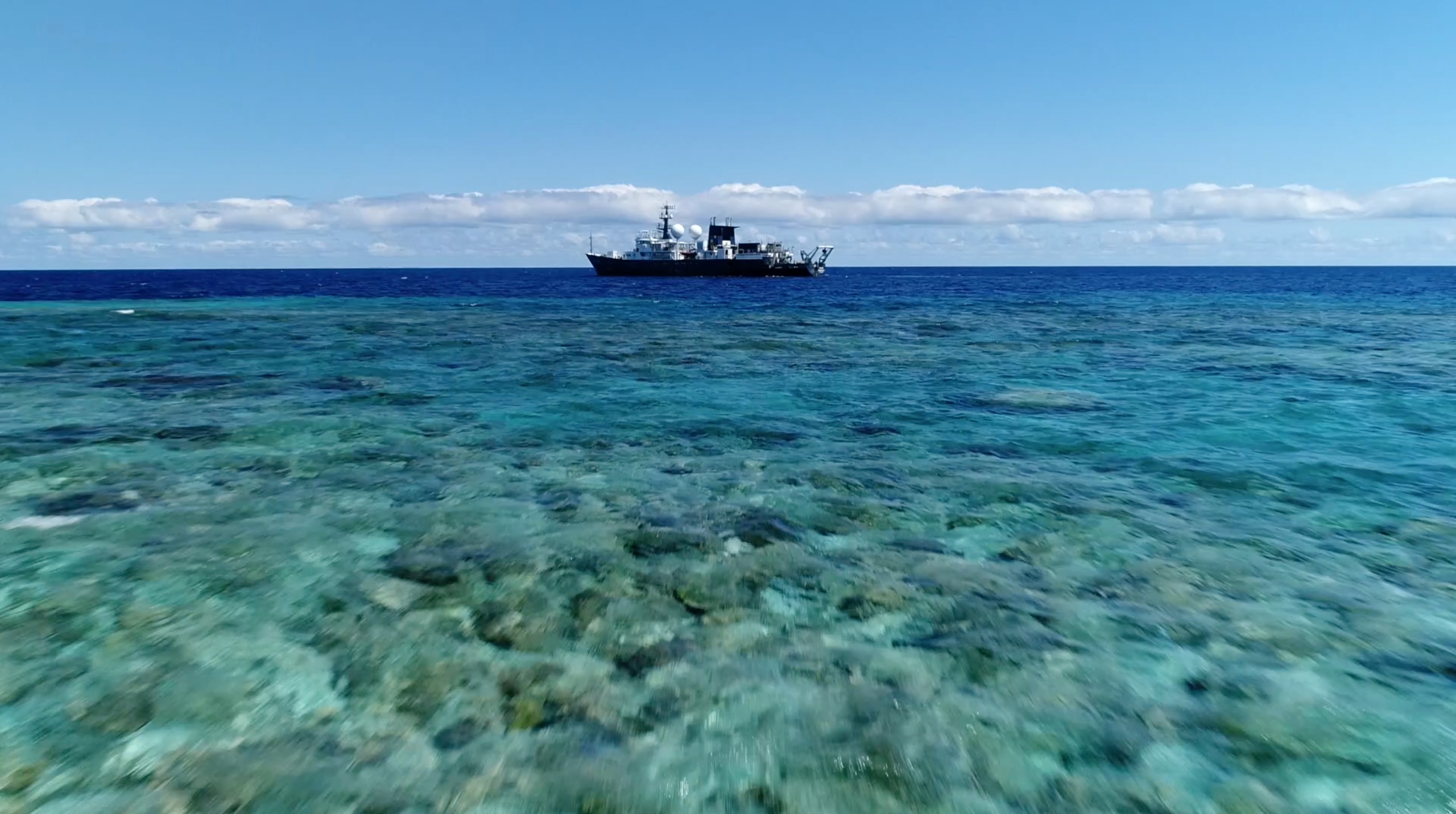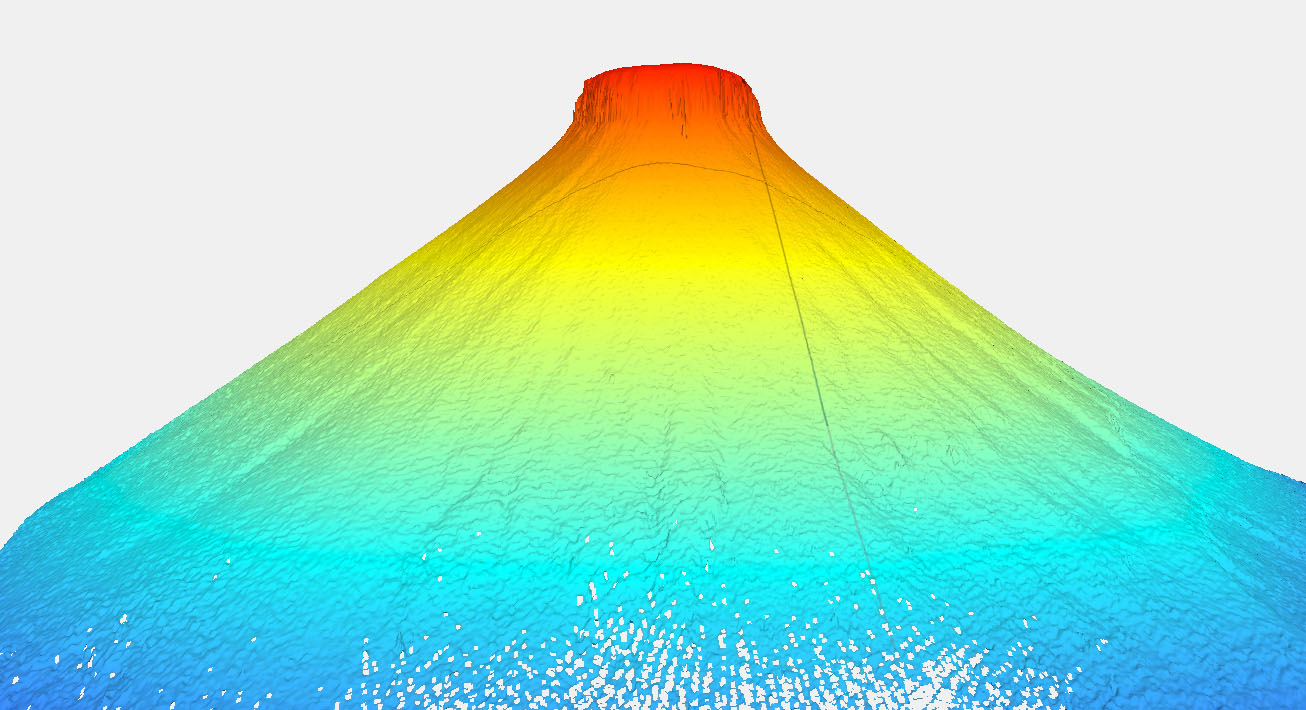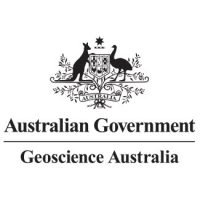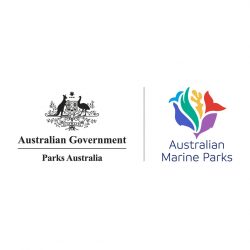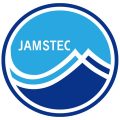The Cape York Peninsula lies in the far northern Great Barrier Reef (GBR) Marine Park. The peninsula is one of the most isolated regions of the Australian continent and little is known about what lies in the offshore deeper waters. Scientists consider these deeper waters to be a frontier area of the GBR. Sparse information from previous mapping expeditions indicates complex deep sea canyons, massive landslides, and detached mesophotic (deep) reefs rising from around 500 meters below the sea surface. However, why these detached reefs exist and the structure of the deep sea canyons are unknown and unexplored. Following two successful cruises – Visioning Coral Seas and Seamounts, Canyons, and Coral Reefs – Dr. Robin Beaman of James Cook University and his Co-PI Mardi McNeil will voyage aboard R/V Falkor for a third time. Their team will utilize mapping and ROV surveys to understand what lies in the northern depths of the Great Barrier Reef.
Astonishing Geologic Features
Continuing on from previous expeditions earlier this year, the science party and the Falkor crew will expand their work taking inventory of the GBR’s submarine canyons and any other unusual geological features. During the transit northwards, the expedition will begin by mapping the Swain slide, a 20 kilometer long underwater landslide discovered off the Swain Reefs. Why this massive landslide exists perplexes scientists, as there are no immediate geologic features to explain how it happened. Bathymetric mapping data and ROV surveys will help describe and determine the age of the Swain slide.
The team aboard R/V Falkor will then map the largely unexplored northern continental slope offshore of Cape York Peninsula. There is limited information about the seafloor in this region and detailed mapping has not yet occurred. Existing maps indicate the canyons of the northern extent have very different structures and characteristics from the Ribbon Reef canyons explored on the previous expedition.
During this Cape York exploration, scientists will utilize R/V Falkor’s advanced multibeam mapping systems to examine the seafloor topography. The goal is to ascertain the formative processes which make these canyons different from other parts of the GBR. The new multibeam data will greatly advance the characterization of Australia’s massive and ecologically important marine estate. All data will be added to the Australian government databases and made publicly available.
Life Along the Reef Slope
ROV SuBastian will work in tandem with the multibeam systems, in order to determine if structurally-different bottom features facilitate the presence of deep-sea coral habitats unique to the region. The ROV data will also allow scientists to examine if the mesophotic (twilight zone) corals have been affected by recent coral bleaching.
As demonstrated by the work done in Bremer Bay, Perth Canyon, and most recently in the Ningaloo Canyons, ROV SuBastian can make a major impact in the discovery of new species, habitats, and in understanding key processes in these little-known ecosystems. In a country where there are few opportunities to explore the deep sea with a dedicated science ROV, this expedition will have a major impact in visioning the Coral Sea.
Drowned and Detached Reefs
The submerged (also known as drowned reefs) shelf edge reefs of the GBR are considered the world’s longest fossil reef. How far north the drowned reefs extend into the Cape York region is unknown and one objective for the mission is to determine the northern extent of the drowned reefs along the shelf edge.
The science team will also examine numerous detached deep reefs – isolated reefs which have grown upon a platform of continental rock that extends out of the slope deeper than the shallower GBR shelf reefs. These reefs may be tens of thousands of years old, rising up from the deeper platform but have completely unmapped bases. The goal is to map and survey the foundation of the reef bases and surrounding platform to gain insight into the detached reef’s formation and ecosystems.
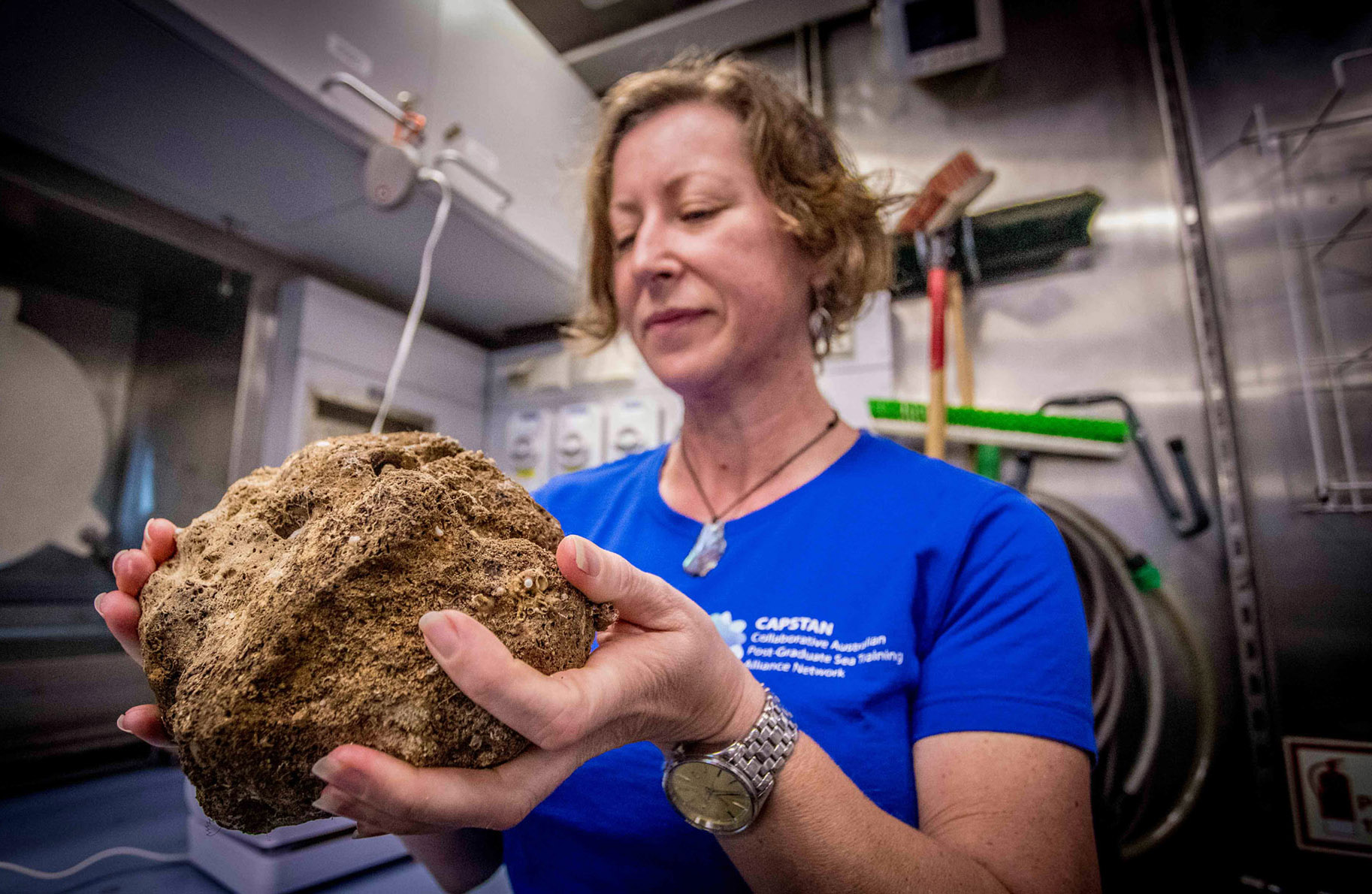
Data & Publications
Annotated images from from this expedition are in Squidle+. [Platform = SOI ROV Subastian, deployment = FK200930].
Preliminary bathymetric grids have been released in AusSeaBed (data combined with data from FK200802).
ADCP data has been processed and is available through UHDAS.
Environmental sensor data is curated and archived at Rolling Deck to Repository.
ROV data is archived at MGDS.
Flythrough video highlights of deep and mesophotic seabed environments within the Coral Sea Marine Park.
An ArcGIS StoryMap on the new Australian national seabed map includes data collected by Falkor in 2020.
- Lindsay, D., Hunt, J., McNeil, M., Beaman, R., and Vecchione, M. (2020). The First In Situ Observation of the Ram's Horn Squid Spirula spirula turns "Common Knowledge" Upside Down. Diversity, 12, 449, doi: 10.3390/d12120449.
- Beaman, R. (2021) Schmidt Ocean Institute R/V Falkor Australia Campaign 2020-2021. Oral Presentation and Conference Paper, Sub-Committee on Regional Undersea Mapping, General Bathymetric Chart of the Oceans, Virtual from Paris, France.
- McNeil, M. (2021). No Pandemic-pause for Multi-disciplinary Reef Exploration in 2020. Reef in Review, 50, 8-10. [This article is published as OPEN ACCES].
- Beaman, R., Picard, K., and Miller, A. (2022). RV Falkor Surveys in Australia 2020-2021. Oral Presentation and Conference Paper, Hydrospatial 2021 Conference, Australasian Hydrographic Society, Cairns, Australia. [Abstract and presentation are OPEN ACCESS].
- Horowitz, J., Opresko, D., Molodtsova, T., Beaman, R., Cowman, P., and Bridge, T. (2022). Five new species of black coral (Anthozoa; Antipatharia) from the Great Barrier Reef and Coral Sea, Australia. Zootaxa, 5213 (1), doi: 10.1164/zootaxa.5213.1.1. [This article is published as OPEN ACCESS].
- Mah, C. (2023). A new species of Astrosarkus from Western Australia including new Mesophotic occurrences of Indian Ocean Oreasteridae (Valvatida, Asteroidea). Memoirs of Museum Victoria 82:143-165, doi: 10.24199/j.mmv.2023.82.08. [This article has been published as OPEN ACCESS].
- Ricci, F., Leggat, W., Pasella, M., Bridge, T., Horowitz, J., Girguis, P. and Ainsworth, T. (2024). Deep sea treasures - Insights from museum archives shed light on coral microbial diversity within deepest ocean ecosystems. Heliyon, 10 (5), doi: 10.1016/j.heliyon.2024.e27513. This article has been published as OPEN ACCESS.
- Final Expedition Report: Northern Depths of the Great Barrier Reef
In the News
Elusive and extremely rare catshark captured in amazing video
Tell it Like it is • February 12, 2021
Scientists discover huge detached reef in Coral Sea
Supreme Master Television • February 2, 2021
Ó, csak egy akkora zátonyt találtak Ausztráliában, ami nagyobb mint az Empire State Building
IGN Hungary • January 10, 2021
Newly Discovered Coral Reef Is Taller Than the Empire State Building
Hiptoro • January 5, 2021
Australian Scientists Discover 500 Meter Tall Coral Reef in The Great Barrier Reef – First to be Discovered in Over 120 Years
SEVENSEAS Media • January 5, 2021
Scientists Discover New Reef In Australia That’s Taller than the Empire State Building
IGN Middle East • January 4, 2021
到2021我才知道,原来恒星也会打嗝
QQ • December 31, 2020
8 Incredible Scientific Discoveries in 2020
Technology Times Pakistan • December 27, 2020
8 Incredible Scientific Discoveries in 2020
Newsweek • December 26, 2020
10 buenas noticias para el planeta y la salud en 2020
El País • December 25, 2020
The deep sea discoveries of 2020 are stunning
Mashable Pakistan • December 23, 2020
The deep sea discoveries of 2020 are stunning
Mashable • December 23, 2020
2020’s top ocean news stories
Mongabay • December 21, 2020
THE TOP TEN OCEAN STORIES OF 2020
Smithsonian Magazine • December 17, 2020
It’s not all bad: “landmark” coral reef found thriving off the coast of Australia
Palatinate • December 8, 2020
The underwater robot that’s helping preserve the Great Barrier Reef (VIDEO)
CNET • December 5, 2020
10 awesome science discoveries you may have missed in 2020
National Geographic • December 3, 2020
This giant coral reef is taller than the Empire State Building (Video)
Mashable • November 17, 2020
A single squid discovered for the first time in the Australian…
al Khaleej Today • November 10, 2020
Three of the World’s Top Female Ocean Explorers Talk Trailblazing Ocean Discovery and Conservation
AltaSea • November 11, 2020
UNEARTHLY, JUST DISCOVERED CORAL REEF PROVES OUR OWN PLANET CAN BE AN ALIEN WORLD
SyFy Wire • November 4, 2020
Australie : découverte d’un nouveau récif corallien géant et de nouvelles espèces
Nouvelle Caldonia • November 5, 2020
A Look at the Aquatic Aliens Around the Great Barrier Reef
Nerdist • November 4, 2020
See Strange Squid Filmed in the Wild for the First Time
Smithsonian Magazine • November 3, 2020
Deep Ocean Dweller Ram’s Horn Squid Caught in Video for the First Time
Nature World News • November 3, 2020
At Last, This Unbelievably Weird Squid Has Been Spotted in the Wild
Popular Mechanics • November 2, 2020
Squid sighting: Scientists share first-ever footage of ‘freaky’ Ram’s Horn squid
Express • November 2, 2020
Coral reef taller than the Empire State building found in Australia
Gulf Today • November 1, 2020
Ram’s Horn Squid: Marine Researchers Capture in Film Elusive Creature in Deep Sea
International Business Times • November 1, 2020
‘MINION’ SQUID FILMED FOR FIRST TIME
Divernet • November 1, 2020
‘They’re Calling You on the Squid Phone’
The New York Times • October 31, 2020
Towering coral reef taller than the Empire State Building discovered in Australia’s Great Barrier Reef
Business Insider South Africa • October 31, 2020
A Pinnacle of Coral Is Discovered in Australia’s Great Barrier Reef
The New York Times • October 30, 2020
Coral reef taller than the Eiffel Tower discovered in the Great Barrier Reef!
The Times of India • October 30, 2020
A thriving piece of coral the size of the Empire State Building was discovered in Australia
Upworthy • October 30, 2020
Coral reef taller than Petronas Towers found
The Straits Times • October 30, 2020
Was a Coral Reef Taller Than the Empire State Building Discovered in the Great Barrier Reef?
Snopes • October 30, 2020
Scientists film elusive, fast creature in the deep sea
Mashable • October 30, 2020
Elusive squid seen alive in natural habitat for first time
Live Science • October 30, 2020
Scientists discover undocumented 500m detached coral reef in Australian waters for the first time in 120 years
Oceanographic Magazine • October 29, 2020
Scientists Are Freaking Out Over The First-Ever Footage of This Bizarre Squid
Science Alert • October 29, 2020
Scientists discover enormous coral reef taller than the Empire State Building
Mirror • October 29, 2020
Great Barrier Reef: Scientists find new coral taller than the Shard
Metro • October 29, 2020
Strange, Rare Deep Sea Squid Filmed Alive in Wild for First Time Ever
Newsweek • October 29, 2020
Scientists are freaking out over the first-ever footage of this bizarre squid
Science Daily Press • October 29, 2020
A great discovery made on Australia’s Barrier Reef
Shine • October 29, 2020
Scientists Discover Coral Reef Taller Than the Empire State Building
Vice • October 29, 2020
Australian scientists find huge new healthy coral reef off northern coast
Malay Mail • October 29, 2020
Scientists discover new section of Great Barrier Reef that’s taller than the Empire State Building
Happy • October 29, 2020
Australian scientists find huge new healthy coral reef off northern coast
The Himalayan Times • October 29, 2020
Reef taller than Empire State Building found off Australia
NWI • October 29, 2020
First Discovery of a New Reef in 120 Years
Technology Times Pakistan • October 29, 2020
A Coral Reef Taller Than the Eiffel Tower Was Just Discovered Off the Coast of Australia
Smithsonian Magazine • October 29, 2020
Se descubre un arrecife de coral de 500 metros de altura
Europa Press • October 28, 2020
Colossal Reef Discovered Off Australia’s Coast Is Taller Than Empire State Building
Science Alert • October 28, 2020
Scientists Find Massive Coral Reef In Australia’s Great Barrier Reef
NPR • October 28, 2020
Tall ‘skyscraper’ reef found off the Queensland coast
Australian Times • October 28, 2020
Huge Great Barrier Reef coral tower found
The Canberra Times • October 28, 2020
Scientists have discovered a coral reef that is taller than the Empire State Building
Interesting Engineering • October 28, 2020
Massive coral reef ‘tower’ found off coast of Australia
Global News • October 28, 2020
Coral reef taller than Empire State building discovered off Australia coast
CBS • October 28, 2020
Coral Reef Discovered By Scientists In Cape York Larger Than The Empire State Building
Inquisitr • October 28, 2020
As it Happens: New Barrier Reef
CBC Radio • October 28, 2020
Australian scientists find huge new healthy coral reef off northern coast
Reuters • October 28, 2020
Massive coral reef discovered off Australian coast
CBC • October 28, 2020
Coral skyscraper taller than Eiffel Tower found on the Great Barrier Reef
Tropic Now • October 28, 2020
Aussie scientists find coral reef bigger than Empire State Building
ABC 9 News • October 28, 2020
First detached reef discovered in more than 120 years is taller than the Empire State Building
Times News Now • October 28, 2020
Reef bigger than Empire State Building discovered off Queensland
RNZ • October 28, 2020
Coral reef the size of the Empire State Building found off Australia’s coast
Fox News • October 28, 2020
How long did this huge coral reef stay hidden? – BGR
Prudent Press Agency • October 28, 2020
Scientists discover a 500-metre-tall coral reef on Great Barrier Reef
Mirage • October 28, 2020
Scientists discover reef that’s taller than the Empire State Building
Axios • October 28, 2020
Scientists discover a 500 meter high skyscraper reef on the Great…
al Khaleej Today • October 28, 2020
Coral reef taller than the Empire State Building discovered in Australia
WION • October 28, 2020
Scientists discovered a coral reef taller than the Empire State Building
Tech Explorist • October 28, 2020
Scientists discover reef taller than Empire State Building at Great Barrier Reef
The Irish Times • October 28, 2020
Scientists discover a coral reef that’s taller than a skyscraper
Lonely Planet • October 28, 2020
Scientists have found the first coral reef in 120 years
Esquire Middle East • October 28, 2020
Massive 500-metre-tall coral structure discovered off Australia
Silicon Republic • October 28, 2020
There Hasn’t Been an Ocean Find Like This in 120 Years
Newser • October 28, 2020
Coral reef taller than Empire State Building discovered at Australia’s Great Barrier Reef
The Indian Express • October 28, 2020
Scientists discover a massive coral reef in Australia’s Great Barrier Reef
Sports Grind Entertainment • October 28, 2020
Scientists discover 500 metre-tall skyscraper coral reef at Australia’s Great Barrier Reef
The Guardian • October 28, 2020
‘Massive’ coral reef taller than the Empire State Building discovered in Australia
7 News • October 28, 2020
Freakishly Tall Coral Reef Found Off the Coast of Australia
Gizmodo • October 28, 2020
First New Reef In Over A Century Discovered Off The Great Barrier Reef, And It’s Huge
IFL Science • October 28, 2020
A Coral Reef Taller Than the Empire State Building Was Just Discovered in Australia
Travel + Leisure • October 27, 2020
Elusive and extremely rare catshark captured in amazing video
CNET • October 27, 2020
Coral reef taller than the Empire State Building discovered in Australia’s Great Barrier Reef
NBC News • October 27, 2020
Gigantic, mile-wide coral reef discovered in Australia
New York Daily News • October 27, 2020
Newly discovered Australian coral reef is taller (1,640 feet) than the Willis Tower (1,450 feet)
Chicago Sun Times • October 27, 2020
New spire found in Great Barrier Reef dwarfs the Empire State Building
New Atlas • October 27, 2020
Scientists ‘Surprised and Elated’ to Find Massive Coral Reef Taller Than Empire State Building
yahoo! news • October 27, 2020
How did this huge reef structure remain hidden for so long?
BGR • October 27, 2020
Massive coral reef taller than Empire State Building found in Australia, scientists say
Miami Herald • October 27, 2020
‘Massive’ coral reef taller than the Empire State Building discovered in Australia
KCTV News • October 27, 2020
Coral reef taller than the Empire State Building found off coast of Australia
Penn Live • October 27, 2020
‘Detached’ reef bigger than Empire State building discovered in 500 metres of water off Queensland
ABC Science • October 27, 2020
A mountain of a reef, taller than the Eiffel Tower, found on Great Barrier Reef
Monga Bay • October 27, 2020
Scientists discover massive coral reef taller than Eiffel Tower, Empire State Building
India Today • October 27, 2020
A coral reef taller than the Empire State Building has been found in Australia
The Hill • October 27, 2020
Scientists ‘Elated’ After Finding Massive Coral Reef—The First Reef to Be Discovered in 120 Years
Good News Network • October 27, 2020
Coral skyscraper taller than the Eiffel Tower found in Great Barrier Reef
Sunday Times Daily • October 27, 2020
Great Barrier Reef: Giant coral reef discovered for first time in over 120 years
BBC • October 27, 2020
Researchers discover ‘massive’ coral reef in Australia that’s taller than the Empire State Building
USA Today • October 27, 2020
Coral Taller than Empire State Building Discovered in Australia’s Great Barrier Reef
UNILAD • October 27, 2020
Australian scientists discover 500-meter-tall coral reef in the Great Barrier Reef
Science Daily • October 27, 2020
Coral bigger than Empire State Building found in Great Barrier Reef
New York Post • October 27, 2020
Ancient coral reef discovered off Australian coast
The Times • October 27, 2020
Coral reef taller than Empire State Building is first discovered in Australia’s Great Barrier Reef for 120 years
The Independent • October 27, 2020
Mammoth coral reef larger than Empire State Building found in Australia
The Weather Network • October 27, 2020
TOWERING REEF DISCOVERED IN GBR
Diver Net • October 27, 2020
Coral Taller than Empire State Building Discovered in Australia’s Great Barrier Reef
News18 • October 27, 2020
ARRECIFE DE CORAL ‘MASIVO’ MÁS ALTO QUE EL EMPIRE STATE BUILDING ENCONTRADO EN AUSTRALIA
La Gradona • October 27, 2020
‘Massive’ coral reef taller than the Empire State Building discovered in Australia
CNN Travel • October 27, 2020
Scientists ‘Surprised and Elated’ to Find Massive Coral Reef Taller Than Empire State Building
People • October 27, 2020
Australian Scientists Discover 500m Tall Coral Reef in the Great Barrier Reef
ROV Planet • October 26, 2020
Ocean Discovery: 500m Tall Coral Reef Discovered in the Great Barrier Reef
Marine Technology News • October 26, 2020
Enormous Coral Reef Taller than Empire State Building Discovered on Great Barrier Reef
Newsweek • October 26, 2020
Underwater coral skyscraper taller than the Empire State Building found in Great Barrier Reef
The Telegraph • October 26, 2020
Great Barrier Reef: Massive underwater coral ‘skyscraper’ is taller than the Empire State Building
The Street Journal • October 26, 2020
500 Meter hohes Korallenriff im Great Barrier Reef entdeckt
RTL • October 26, 2020
Wissenschaftler entdecken bisher unbekanntes Korallenriff
Spiegel • October 26, 2020
QUT scientists set sail on voyage of discovery to outer edge of the Great Barrier Reef
QUT Science Engineering • October 1, 2020
